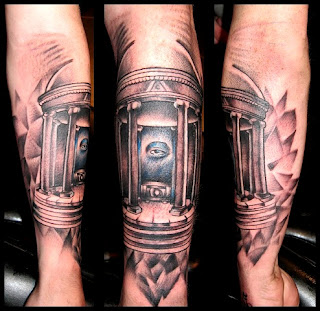by Moe | Jul 7, 2016 | Tattoos
Many millions of people today such as myself are mysteriously drawn to the painful art form known of as tattooing, and some of us do not 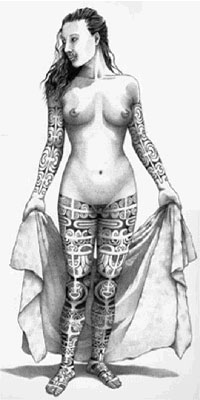 know why. I believe the reason to be a common thread that some of us share to the past. A past that deals with thousands of years of ink, blood, honor and tribal identity.
know why. I believe the reason to be a common thread that some of us share to the past. A past that deals with thousands of years of ink, blood, honor and tribal identity.
An art form, that would actually become a threat to the church in the 4th century when the first Christian emperor of Rome had banned facial tattooing of slaves and prisoners, and later Pope Hadrian in the year 787 who had prohibited all forms of tattooing. More measure would be employed, and in fact, a passage in the bible would be created that would make this age old custom of tattooing now considered a sin; as seen in Leviticus 19:28 –
“Ye shall not make cuttings on your flesh (body) on account of a soul, i.e., a dead person (נפשׁ equals מת נפשׁ, Leviticus 21:11; Numbers 6:6, or מת, Deuteronomy 14:1; so again in Leviticus 22:4; Numbers 5:2; Numbers 9:6-7, Numbers 9:10), nor make engraven (or branded) writing upon yourselves.” (more…)
Moe is the founder of GnosticWarrior.com. He is a father, husband, author, martial arts black belt, and an expert in Gnosticism, the occult, and esotericism.
by Moe | Oct 13, 2014 | Meaning of Words, Tattoos
The meaning of the English word tattoo first originated from the Greek word Tau which signifies the symbol of life, and the word to (tu), meaning to identify the person or thing affected.
the symbol of life, and the word to (tu), meaning to identify the person or thing affected.
In ancient times, to be tattooed was often considered as a sign of tribal origins, and a symbol of noble birth. Sometimes it was known as a mark of life or death. For example, in ancient Greece when they placed the mark of the Tau tattooed on a prisoners forehead, this meant the person was found innocent of his or her crimes, and no longer a marked man for death. According to Herodian, in Europe the various tribes tattooed their tribal marks on their foreheads, and covered their bodies.
Manly P. Hall had said this about the Tau Cross and Tattoos; “The TAU cross was inscribed on the forehead of every person admitted into the Mysteries of Mithras. When a king was initiated into the Egyptian Mysteries, the TAU was placed against his lips. It was tattooed upon the bodies of the candidates in some of the American Indian Mysteries. To the Qabbalist, the TAU stood for heaven and the Pythagorean tetractys. The Caduceus of Hermes was an outgrowth of the TAU cross. (See Albert Pike.)” (more…)
Moe is the founder of GnosticWarrior.com. He is a father, husband, author, martial arts black belt, and an expert in Gnosticism, the occult, and esotericism.
by Moe | Oct 18, 2013 | Apocalypse, History of the Brotherhood, Tattoos
The tattooed skin of Epimenides was preserved at the courts of the ephores in Sparta, allegedly as a good-luck charm. 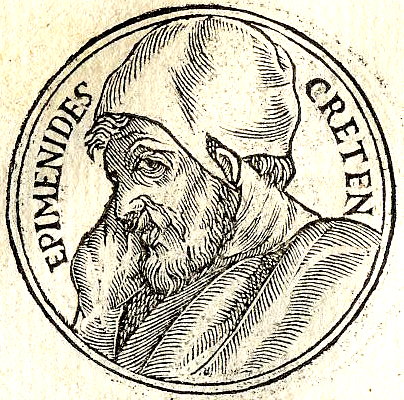
One of the founders of the ancient Gnostic mysteries of Orphism, was said to be a Cretan man named Epimenides (Greek: Ἐπιμενίδης), whose tattooed body and skin were held venerable by the ancient Spartans because it was said to reveal “secret things.” Epimenides had lived in the 7th century B.C. and was born in the city of Gnosis, which today is called the city of Knossos on the modern-day island of Crete in the Mediterranean Sea.
To the Spartans, he was the chief shaman of their people, who was not only a seer, poet and advisor, but he was also a prophet who specialized in searching the past for truth. Hence, his knowledge was retrospective based on his Gnosis which is old knowledge relearned from the blood. A talent, that was once respected by the ancients and the world’s most powerful people for thousands of years. (more…)
Moe is the founder of GnosticWarrior.com. He is a father, husband, author, martial arts black belt, and an expert in Gnosticism, the occult, and esotericism.
by Moe | Jun 20, 2013 | Freemasonry, Tattoos
(Source: Todd E. Creason) – Dad and grandpa displayed their Masonic affiliations with a nice ring, or a lapel pin–and of course the always popular automobile emblems. But there is a new generation of Masons coming up through the ranks, and instead of showing their fraternal pride in the more traditional way, they are showing their Masonic affiliations in a more permanent way.
With Masonic Ink . . .
 It’s a popular subject. Nearly two years ago I wrote a short piece on the subject, and it continues to get a large number of hits. Over my travels these last several years, I’ve seen a lot of Masonic ink. And many Masons have sent me photographs of artwork they’ve had done, or artwork they’ve run across.
It’s a popular subject. Nearly two years ago I wrote a short piece on the subject, and it continues to get a large number of hits. Over my travels these last several years, I’ve seen a lot of Masonic ink. And many Masons have sent me photographs of artwork they’ve had done, or artwork they’ve run across.
And I can certainly see why Masonic tattoos are so popular. First of all, the symbols are intriguing, and every Mason seems to
identify with one in particular that is meaningful to them. Secondly,
tattoo artists seem to really enjoy working with those traditional
designs.
Some of the artwork I’ve seen is absolutely stunning. There are York Rite designs that feature the symbolism of the Chapter, Council and Commandery. There are Blue Lodge designs that feature the All Seeing Eye, and the Square and Compasses. There are Shriner designs that feature scimitars and pyramids.
 I’m not quite ready to go under the needle quite yet, but I enjoy looking at the artwork others have had done, and judging for the success of my last blog on the subject, I’m not the only one.
I’m not quite ready to go under the needle quite yet, but I enjoy looking at the artwork others have had done, and judging for the success of my last blog on the subject, I’m not the only one.
So what I thought I’d do is open this up. Have you got a Masonic tattoo you’d like a share? Take a picture of it, and send it to me at [email protected]. I thought I’d create a permanent album of these photos. Be sure and include your name, lodge, and location.
~TEC
ORIGINAL ARTICLE LINK
Todd E. Creason is an author and novelist whose work includes the award-winning non-fiction historical series Famous American Freemasons and the novels One Last Shot (2011) and A Shot After Midnight (2012). He’s currently working on the third novel expected to be
released in 2014. All of Todd E. Creason’s books are sold at major online booksellers like Amazon.com and Barnes & Noble and are available for both Nook and Kindle.
Moe is the founder of GnosticWarrior.com. He is a father, husband, author, martial arts black belt, and an expert in Gnosticism, the occult, and esotericism.
by Moe | Mar 2, 2013 | Apocalypse, Freemasonry, Tattoos
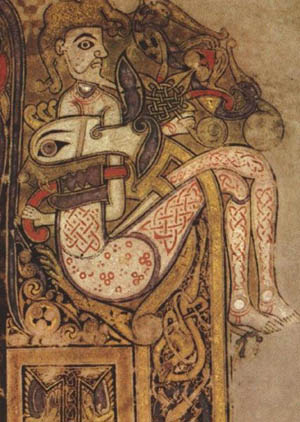 During the course of my research into ancient tattoos, I had come across this fascinating book on Gnosticism written during the 18th century. The book is titled, The Gnostics and Their Remains, Ancient and Mediaeval by Charles William King and in it the author describes this mysterious tattooed man that adorns the artwork of the Book of Kells. He also relates these tattoos to a fascinating and believable connection between Ptolemy Philopator who had received Dionysiac brand-marks, St John, Masonic Brand marks and biblical prophecy.
During the course of my research into ancient tattoos, I had come across this fascinating book on Gnosticism written during the 18th century. The book is titled, The Gnostics and Their Remains, Ancient and Mediaeval by Charles William King and in it the author describes this mysterious tattooed man that adorns the artwork of the Book of Kells. He also relates these tattoos to a fascinating and believable connection between Ptolemy Philopator who had received Dionysiac brand-marks, St John, Masonic Brand marks and biblical prophecy.
This reference to the Book of Kells I had confirmed in my own library by seeing this man that is obviously heavily tattooed in a blue ink. There is also another tattooed man with blond hair covered with red Celtic knot tattoos that is pictured to the left.
It is interesting to connect the tattoos left by these ancient brothers and sisters from Egypt, to Greece, and then to the West in countries such as Gaul, Ireland, Scotland and Denmark. These revelations are just more historical clues that add to the mounting apocalyptic physical evidence that has been left by these peoples for us historians.
Below is the excerpt that I’m writing about from the book, The Gnostics and Their Remains, Ancient and Mediaeval;
“The Book of Kells” is a MS., written some time in the ninth century. In one of the facsimiles of its pages published by the Palæographical Society, amongst the ornamentation of one vast initial letter, the most conspicuous is the figure of a naked man, writhing himself amongst its most intricate convolutions.
This man’s body is entirely covered with “marks” of various forms; and from the circumstances under which the drawing was made we can safely assume that we have here preserved to us the portrait of a true Pict, taken from the life. (more…)
Moe is the founder of GnosticWarrior.com. He is a father, husband, author, martial arts black belt, and an expert in Gnosticism, the occult, and esotericism.
by Moe | Feb 28, 2013 | Apocalypse, Tattoos
“What greater glory could there be Than to be clothed with God? He drew His skin upon my skin, His blood upon my blood.” – 1754 English Hymn
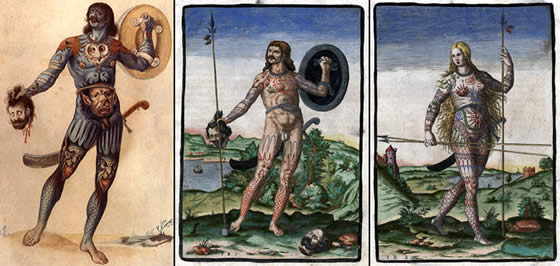
For thousands of years, tattoos have adorned the skin of many of our ancestors. It was said that in many tribes, that no one could tattoo other tribal members, but the priests; and the art of tattooing, like their religious customs, was passed down within the same families from one generation to the next. Hence, just like the priesthood was a profession whose teachings were hereditary, so was the marking of one’s skin.
These ancient accounts of painted men and tattoos come to us from all over the globe. However, my research below proves a biblical tattoo connection between the East and West that had really gained momentum when a dominant class of tattooed rulers from the early Egypt and Greek royal dynasties in approximately 2100 – 1500 BC had spread their custom around the world. (more…)
Moe is the founder of GnosticWarrior.com. He is a father, husband, author, martial arts black belt, and an expert in Gnosticism, the occult, and esotericism.
 know why. I believe the reason to be a common thread that some of us share to the past. A past that deals with thousands of years of ink, blood, honor and tribal identity.
know why. I believe the reason to be a common thread that some of us share to the past. A past that deals with thousands of years of ink, blood, honor and tribal identity.



